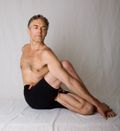10 Jul Richard Freeman returns to Telluride for Yoga Fest
[click “Play” to hear Richard Freeman]
 When Richard Freeman returns to the Telluride Yoga Fest this weekend, June 10 – 12, for his encore, legions of devoted followers will be lining up for his classes on alignment, mulabandha (not what you think), backbends, shoulder stand, and headstand – and with good reason: Richard Freeman is unique, even among princes of the mat, a magnetic combination of guru, gumby, and wit.
When Richard Freeman returns to the Telluride Yoga Fest this weekend, June 10 – 12, for his encore, legions of devoted followers will be lining up for his classes on alignment, mulabandha (not what you think), backbends, shoulder stand, and headstand – and with good reason: Richard Freeman is unique, even among princes of the mat, a magnetic combination of guru, gumby, and wit.Freeman is a teacher’s teacher, who lost his principal teacher last month, Sri K. Pattabhi Jois, 1915-2009, the smiling, pot-bellied man who favored Calvin Klein shorts and famously said, “Do your practice and all is coming.” Yoga is 99 percent practice and 1% theory.
Yoga has entered the mainstream in the West, particularly in urban centers: everywhere people who drive Priuses and eat organic veggies are practicing one of the many flavors of Hatha yoga, the yoga of action. Devotees are divided into tribes: Iyengar students obsess about building precisely articulated poses with straps, blocks and bolsters. Ashtangi just go for it: they tend to be ripped from all the stretching, toning and balancing moves of the six series. Freeman, originally an Astangi, is no exception – but with a mind as toned and flexible as his body.
 I was privileged to be one of the faces in the crowd last year when Richard Freeman taught at the nascent Telluride Yoga Fest and I have to admit, although I am a card-carrying member of another tribe – I am a Viniyoga instructor – I was mesmerized by his metaphorical teaching style. (I seem to be drawn to brainiacs like Freeman. The senior teacher in my lineage, Gary Kraftsow, also possesses astonishing intellectual dexterity.)
I was privileged to be one of the faces in the crowd last year when Richard Freeman taught at the nascent Telluride Yoga Fest and I have to admit, although I am a card-carrying member of another tribe – I am a Viniyoga instructor – I was mesmerized by his metaphorical teaching style. (I seem to be drawn to brainiacs like Freeman. The senior teacher in my lineage, Gary Kraftsow, also possesses astonishing intellectual dexterity.)
Richard Freeman talked about his students becoming “connoisseurs of the breath,” enjoining us to “breathe as if we were invoking our true love and paste the mantra on top.” Suggestions with regard to the biomechanics of asana included “lifting the ‘happy pot’ off the pelvic floor to expose it to awareness.” “Splay open your toes so the feathers of your buttocks open.”
In Freeman-speak, the central channel of our body, the susumna, is “where the You of you swells.” The inhale is the “summer solstice,” the formation of life, and the exhale – you guessed it – is “like death.”
Freeman’s metaphor for an asana practice: “Churn until you get butter.” And Yoga?” At least at the entry level of asana: “Yoga is the reawakening of the tailbone.”
Richard Freeman began studying Yoga in 1968, the same year the wars in Vietnam and the black ghettos were brought into everyone’s living room through the medium of TV. Students were rioting on college campuses and both Robert F. Kennedy and Martin Luther King were shot dead. Lyndon Johnson’s presidency was ending. The Nixon era was about to begin. Freeman stayed in Asia for nine years, studying various Eastern traditions.
Although Ashtanga is the linchpin of his practice, Richard Freeman’s comprehensive background also includes the study Sufism in Iran, Zen and Vipassana Buddhist practices, Bhakti and traditional Hatha yoga in India.
In 1974, Freeeman began an in-depth study of Iyengar yoga, which eventually led him to the Ashtanga Vinyasa yoga he teaches, a potent hybrid. At workshops, Freeman tends to blend yoga methodologies and philosophies with impunity, because the threads that bind them together – the teachings of the early Upanishads that blossom in later in the practices of Hatha Yoga and Tantra – are firmly within his grasp. He also tends to be liberal with humor, knowing complex lessons go down better with honey rather than vinegar.


Sorry, the comment form is closed at this time.